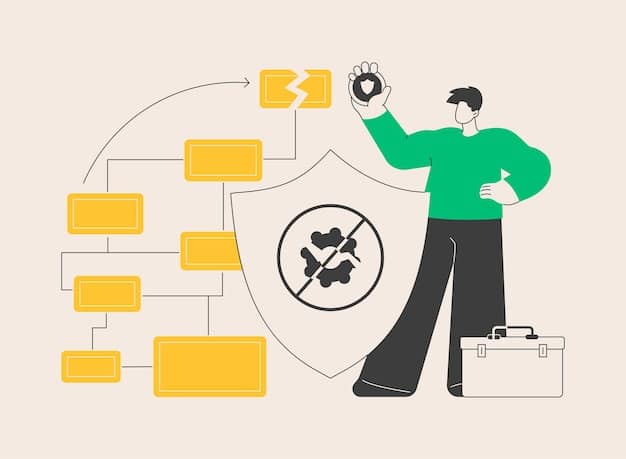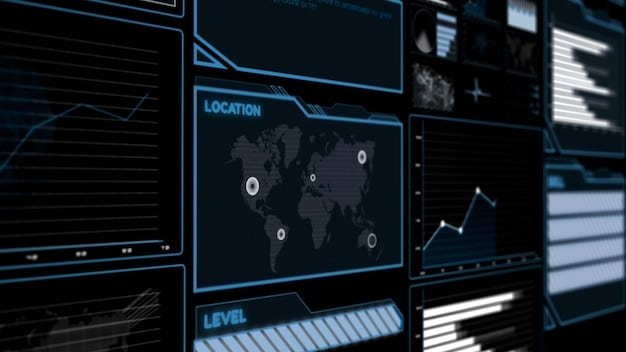Vulnerability Management: Secure Your Systems Before Hackers Do

Vulnerability management is the process of identifying, classifying, remediating, and mitigating vulnerabilities in software and hardware to reduce the risk of exploitation by attackers.
In today’s digital landscape, where cyber threats are constantly evolving, a robust security posture is essential for every organization. Vulnerability management: identifying and patching security flaws before attackers exploit them, is a critical component of this posture, acting as a proactive defense against potential breaches and data loss.
Understanding the Core of Vulnerability Management
Vulnerability management is more than just a scan; it’s a comprehensive process. Understanding its core components is essential for building a robust security strategy. Let’s dive into what vulnerability management truly entails.
The Identification Phase
This initial step involves discovering potential weaknesses in your systems. It’s like performing a health check for your digital infrastructure.
The Assessment Stage
Here, the identified vulnerabilities are analyzed to determine their potential impact. This helps prioritize which issues need immediate attention.
- Regularly scan systems for known vulnerabilities.
- Use automated tools to expedite the identification process.
- Stay updated on the latest vulnerability databases and advisories.
Effective vulnerability management starts with a clear understanding of the threat landscape and the specific vulnerabilities that pose a risk to your organization. Tools alone aren’t enough; it requires a deep understanding of your environment and the potential threats it faces.

The Importance of Regular Vulnerability Scanning
Regular vulnerability scanning is a fundamental practice in vulnerability management: identifying and patching security flaws before attackers exploit them. It acts as the first line of defense against emerging threats.
Why Scan Regularly?
The digital landscape evolves rapidly. New vulnerabilities are discovered daily, making regular scanning crucial.
How Often Should You Scan?
The frequency of scans depends on the organization’s specific risk profile. However, frequent scanning is always better.
Effective vulnerability scanning requires the right tools, a well-defined process, and a commitment to addressing found issues promptly. It is a continuous process, not a one-time event.
Strategies for Effective Vulnerability Prioritization
Not all vulnerabilities are created equal. Prioritizing which ones to address first is crucial for efficient resource allocation. Here are some strategies to help you prioritize effectively.
Risk-Based Prioritization
This involves assessing the potential impact and likelihood of exploitation of each vulnerability.
Severity Scoring Systems
Using systems like CVSS (Common Vulnerability Scoring System) provides a standardized way to assess vulnerability severity.
Prioritizing vulnerabilities effectively allows security teams to focus on the most critical risks first. Factors such as asset criticality, potential impact, and ease of exploitation should all be considered when establishing a prioritization framework.
Remediation Techniques: Patching and Beyond
Once vulnerabilities are identified and prioritized, the next step is remediation. Patching is a common technique, but there are other approaches to consider.
The Role of Patch Management
Patching involves applying software updates to fix known vulnerabilities. It’s a critical part of vulnerability management: identifying and patching security flaws before attackers exploit them.
Compensating Controls
In situations where patching is not immediately feasible, compensating controls can reduce the risk.
- Implement a robust patch management system.
- Categorize compensating controls based on the specific vulnerability.
- Regularly review compensating controls for effectiveness.
Remediation goes beyond simply patching vulnerabilities. It involves implementing a combination of technical and administrative controls to mitigate the risks they pose. It’s essential to have a comprehensive remediation plan in place.

Tools and Technologies Used in Vulnerability Management
Choosing the right tools and technologies is critical for successful vulnerability management: identifying and patching security flaws before attackers exploit them. The market offers a variety of options.
Vulnerability Scanners
These tools automate the process of identifying vulnerabilities in systems and applications.
Patch Management Systems
These solutions streamline the process of deploying and managing software patches.
Selecting the correct tools is just one piece of the puzzle. To truly benefit from tools, organizations must integrate solutions into existing workflows. Effective tool integration requires clear communication and collaboration.
Integrating Vulnerability Management into the SDLC
Integrating vulnerability management into the Software Development Life Cycle (SDLC) is essential for “shifting left” and proactively addressing vulnerabilities early in the development process.
Why Integrate?
Early integration helps identify and fix vulnerabilities before they make it into production code.
How to Integrate
There are several ways to integrate vulnerability management into the SDLC, including static and dynamic analysis.
Integrating vulnerability management into the SDLC is not just about finding vulnerabilities, but about fostering a culture of security throughout the development process. Security should be a shared responsibility, with developers, testers, and security professionals working together to build secure software.
| Key Aspect | Brief Description |
|---|---|
| 🔍 Scanning | Regular scanning to detect vulnerabilities. |
| 🛠️ Remediation | Patching and other techniques to fix flaws. |
| 🛡️ Prioritization | Focusing on the most critical vulnerabilities first. |
| SDLC | Integrating security into software development. |
Frequently Asked Questions
▼
The primary goal is to minimize the risk of cyberattacks by identifying and addressing security vulnerabilities before they can be exploited by malicious actors.
▼
The frequency of vulnerability scans should be determined based on the organization’s risk profile and industry best practices, but daily or weekly scans are ideal.
▼
Vulnerability scanning identifies known vulnerabilities, while penetration testing actively attempts to exploit those vulnerabilities to assess the impact of a successful attack.
▼
A compensating control is an alternative security measure implemented when a direct fix or patch is not immediately available or feasible for a identified vulnerability.
▼
Automation streamlines the vulnerability management process by promptly and consistently identifying and classifying flaws, enhancing security posture.
Conclusion
Vulnerability management: identifying and patching security flaws before attackers exploit them is a necessity in today’s threat-filled digital landscape. By employing the strategies and techniques outlined in this article, organizations can significantly improve their security posture and reduce the risk of costly cyberattacks.





